2004
7th January 2004
Binon – design – solution
Habit – Analysis – Requirement
Relationship vs. Association
Permanent stimulus – permanent memory
Simultaneous binons
Feelings associated with stimuli – not form a relationship/habit but door closing sight and sound form relationship. Simultaneous binons – if either one is missing, you are surprised.
Feelings are a property of a stimulus.
Stimulus properties are Associated to it.
[Sense ] combined
[Feature]
Value (absolute or relative) or Habit composite
Feeling
Simultaneous/Sequential (ordered)
Either/Both needed (permanent)
Its response
Same – both inputs needed – match
Similar – only one input matches
Two levels of concentration in thought – free flowing (next/next/next) and purposeful/goal-oriented.
Without reward/punishment – goal is to obtain interesting (novel) stimuli or combination of stimuli.
Learn to think – responses are - get next stimulus, get other property
– stimuli are familiar, novel, no property found (LOOP recognized), similar one matches
Recall items from STM
8th Jan, 2004 Simultaneous Binons
/N - Novel
/F - Familiar
Start with Two different features External-Pitch and Internal-Volume
Upper Case and Lower Case
1st A
A/N a/N a produces A or a or Aa End with A/F, a/F
or produces Aa in either state and unordered.
Next A A matches 1st Same – confirms pair occur both together
1/N a a matches 2nd change to Both state (permanent) * not yet
Store a Habit #1 learnt to recognize the pair 1/F
or Next A A matches 1st = Similar – same type produces Ab A/F, b/F
A/F b/N b enough to trigger #1 and recall it if it exists in the either state
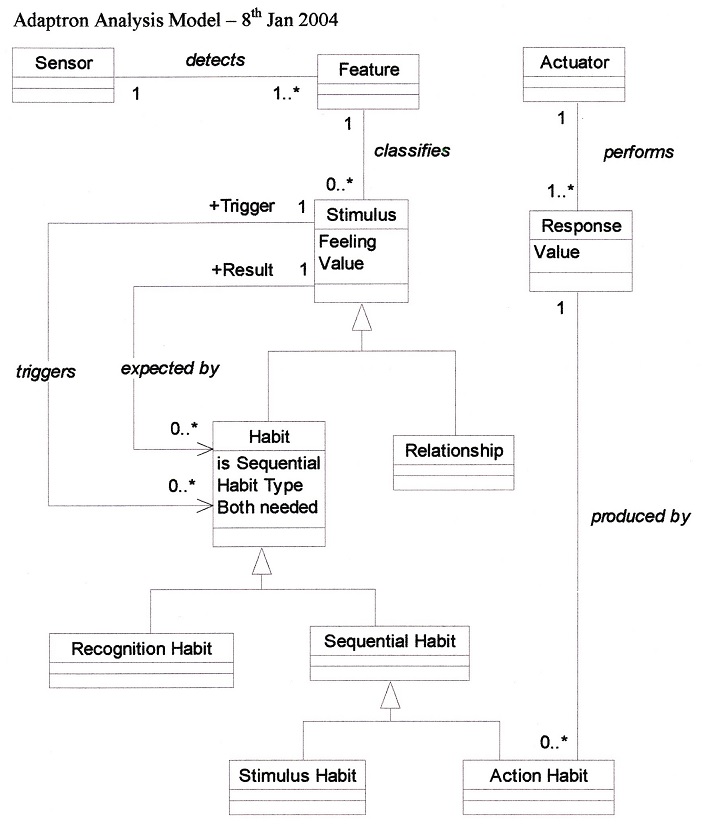
9th Jan, 2004 Simultaneous binons
Recognize stimuli from 3 dimensions need to capture 2nd and 3rd order differentiation i.e. pairs and the 3 together.
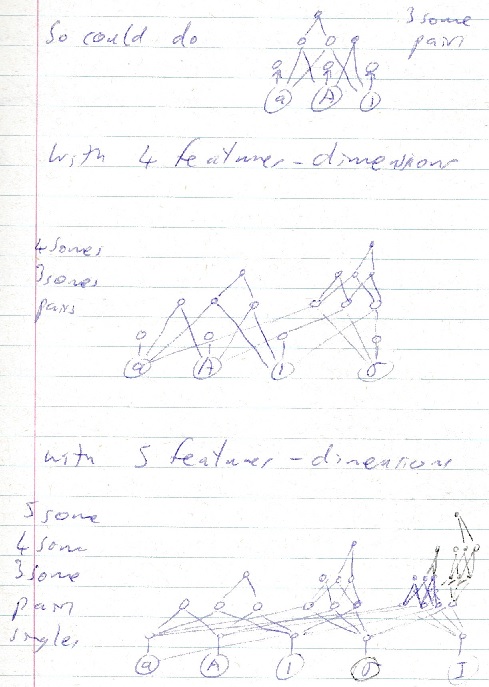
This approach only combines binons from the previous level – An approach which uses lowest level ones instead is:
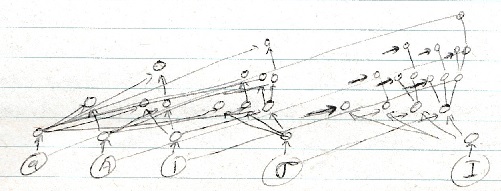
In simultaneous binons the order in which they occur is not important just as long as the appropriate number of combinations is represented.
In sequential binons order is important and this gives rise to additional combinations that are possible. It is based on unique stimuli independent of feature.
So A and B can be recognized as A, B, AB or BA.
Given 3 values A, B, C can be recognized as:
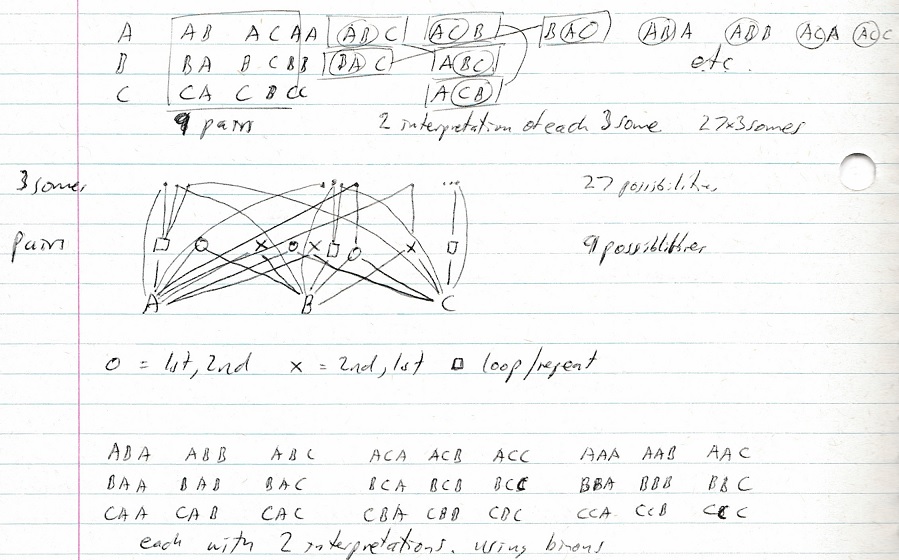
Add a 4th stimulus gives 27 x 4 by inserting D in the above 3somes plus 9 x 3 by inserting DD in pairs + 3 x 2 by adding DDD to singles plus 1 = DDDD – many possibilities. But given one string how many possible interpretations are there of it using binons – similar to simultaneous binons but less – I think.

Possibly the length of STM determines # of possibilities. Given finite / short length of STM eventually it has to chunk the data one way or another to be able to recognize or keep it in STM.
If we restrict STM to 2 stimuli then given a novel stimulus STM gets flushed to LTM. Given a familiar stimulus and STM is empty then this 1st stimulus stays in STM waiting for the next one. If a 2nd familiar stimulus is received then if it matches experience it collapses to just one (recognized). If collapse is novel it goes to LTM. If collapsed is familiar it stays in STM waiting for the next one. If 2nd familiar stimulus does not match experience then 1st one is put in LTM and 2nd becomes 1st waiting for next.
If STM is set at 3 stimuli then given a novel stimulus STM gets flushed to LTM. Given a familiar stimulus and STM is empty then this 1st stimulus stays in STM waiting for next one (expected). If a 2nd familiar stimulus is received then if it matches expected (experience) it collapses to just one (recognized) stimulus. If collapse is novel it goes to LTM. If collapse is familiar it stays in STM waiting for next one. But if 2nd familiar stimulus does not match any expected then it is placed as 2nd stimulus in STM. Then a 3rd familiar stimulus occurs. If it matches expected of 2nd it collapses and either is novel (flushed) or familiar kept as 2nd and expecting. If 3rd familiar stimulus is not expected by 2nd then 1st goes to LTM, 2nd becomes 1st and 3rd becomes 2nd expecting based on experience. This is equivalent to saying if 1st does not get expected next stimulus save 1st in LTM and see if next stimulus matches anything. * Except 1st followed by collapsed 2nd may collapse to produce new 1st – so not equivalent.
This would imply 1st did get next expected stimulus – 1st one of the collapsed 2nd. So it is equivalent to save 1st in LTM if 1st not get expected.
It’s possible to – Can think of any combination of properties / features whether combination is a real object or not. Can give the combination a word / name and deal with it as a unit, e.g. cure for Shingles. It does not exist but can think of it.
Occam’s razor – When given a number of solutions and none of them are provable, the simplest is the most likely to be correct. or
One should not increase, beyond what is necessary, the number of entities required to explain anything.
1st A,a: both are novel chooses kinaesthetic 1st so “a” is stored and get A/N a/F – Recognize lowest 1st.
2nd A,a: A is Novel so store it, Aa also produced but it is 2nd order stimulus – now A/F a/F, a will match previous input.
3rd A,a: Aa is novel so store it – 2nd order is novel – This is highest level of differentiation amongst 2 stimuli – Given 3 stimuli we could produce 2nd order pairs and 3rd order pairs etc. 4 stimuli up to 4 order of differentiation. But with 2 only can do 2nd order – now only differentiation left is in time (temporal). Aa is in new state.
4th A,a: occurs again both “A” and “a” are familiar and match exactly with their past experiences giving numerous expectations and get a match (both exact) with Aa with its expectations. This is the 1st match with Aa (both match) so create a recognition habit for it in state of “Either” stimulus will trigger.
5th A,a: occurs again – matches exactly Aa and it exists as a recognition habit so now change its state from “Either” to both required to trigger it.
What if just one of “A” or “a” occurs? Let us say A occurs but not a, get b instead. Assuming b is familiar. Will get A match and its expectation, will get b match and its expectations, will get Ab in whatever state (new, either, both) and the A will trigger the Aa if it is in new or either state but not the both state.
10th Jan 2004
Permanence is a property of a trigger stimulus saying - don’t generate reflexive response after it occurs – only wait for next input. Permanence does not determine its interest level.
There are lots of different stimuli and many matches in LTM for any given simultaneous composite stimulus.
Each individual simple stimulus matches – similar + same.
All combinations of composite stimulus matches – similar + same
Any sequential stimulus recognized so far.
What are interest levels based on to choose which stimulus to attend to if not doing previous experience?
Interest level is based on:
Trigger stimulus Familiar / Novel
Good / Bad
Familiar and Matches Exact, Same, Both / Either, Similar
Match is Learnt / Not Learnt i.e. Habit is Familiar / Novel
Expected Result is: Good / Bad
Expected Result is: Familiar / Interesting
What about whether Trigger stimulus is Interesting?
It’s learnt and habit is: Either / Both
Associating a feeling of good – value – to a neutral object saves us from having to think all the time. Money is a good example – A $50 note has value intrinsic in the object but we don’t have to think about why each time we see one. But if on Jan 1st next year the Government says the $50 bill will no longer be legal tender / acceptable currency due to counterfeiters and no longer used as valid currency it will just be a colourful piece of paper every time you see it. So as long as its value continues to be reinforced it retains that feeling association.
This feeling of value can propagate backwards to predecessor objects. If $50 bills are frequently found growing on apricot trees then the trees take on value. This is all value from the good feeling – What about the novelty feeling. Do we actively create novelty or just explore for it. Artist / Inventors actively create it – think about it too. Novel patterns are combinations of properties. Thus new inventions are interesting due to their novelty and the possibility they have for generating more novelty. The recent interest in carbon bucky-balls and bucky-tubes are a good example of the interest generated by a new invention, even if it has no value (yet).
Trigger stimulus can change from permanent state to interesting if followed by novel stimulus! – Only happens in a dynamic environment.
Feeling associated with stimulus not a new relationship / stimulus formed – All $50 have value or none do. Unless some property determines its value or none do. Unless some property determines its value rather than the whole e.g. a good or bad battery – need to test its charge. Good or bad $50 bill based on serial # or type of paper (counterfeit) etc. Value is associated with the property (charge, Serial#, paper type) and the whole gets value because part of it has value as in a simultaneous binon.
In a sequential binon the whole only seems to get value if the result has value.
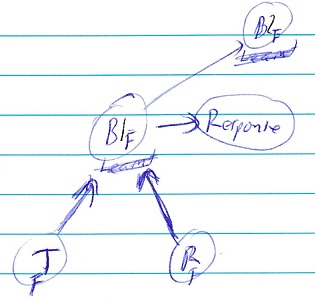
Stimulus matches result of S-Habit – do we have expectation of trigger?
11th January 2004
If response done expect to get RF – will trigger some other B – will result in B1F which will trigger B2F.
Practice first time memory trace = TF RF (expected) Do response Do RF collapse habit proven
Next time – TF RF (expected)
If response done we expect to get the resulting stimulus which
– will trigger some other binon,
– will result in this binon being recognized which will trigger another binon?
V = Value, G = Good, F = Familiar, R= Result, T = Trigger, N = Novel.
1st time ever Tf Reflex response Rg
Next time practice Tf, Rg expected, Do response, Do Rg concentration level high
–> collapse into habit 1
–> Tv rewards simultaneous binon that is T
Habit 1 is a successful behaviour – something that can be done. It is a domain specific application of this response. It now knows if it wants an Rg it does this response after Tf.
Next time do Tv, Rg expected, Do subconscious H1, listen (low concentration level)
When practising
Get unexpected result produces feeling of failure, annoyance.
Get expected result produces feeling of success, satisfaction, accomplishment.
Memory
Declarative – Semantic – facts – simultaneous
– Episodic – events – sequential
Associations such as word sound and word image and corresponding real world object all learnt episodically and don’t form binons – Thinking traverses them.
But features of an object are focused on sequentially and then feel like they are recognized simultaneously.
Consider output – many muscles / actuators each of which can be sent numerous response values.
1/ A twitch is simple muscle, single instantaneous (ballistic) response value.
2/ Extend arm, make a fist (close hand) use multiple muscles, each sent a single instantaneous (ballistic) response value.
Sequence 1’s and 2’s and you have behaviour sequence tie shoelace or dance.
Let’s just investigate learning sequences of 1’s to start with.
Each muscle has a feedback stimulus saying what position it is in. Given one position as a trigger stimulus and a desired result position if it has been learnt (practised) you can perform the task. It’s a habit. An Action habit contains this instantaneous response (ballistic) procedural knowledge.
12th Jan. 2004 Test case
STM length 3 test case: ABCXYZXBCMABC
13th Jan 2004 R-Habits, Action Habits
The binon represents the goal – a way of accomplishing it – a means to an end (in a given context). So when the binon is the result of a higher binon what does it mean?
So got H1 can get Goal Rg
TH1 would only want to be done if H1 also felt good or interesting.
H1 Rg would only be useful after doing H1 and being conscious of doing it.

What I do is a response, result (feedback) e.g. move my finger to get a visual effect.

I see my glass of water is empty and I want to get a glass of water – string of multiple actions – get up, walk to tap, turn on tap, fill glass etc.
Trigger Response Result
Empty glass Do it all glass of water as expected
& Thirsty
Response made up of responses already known – get there, fill glass
Get there is made up of get up, walk to tap.
Get up is made up of plant feet, rise.
Fill glass is made up of turn tap on, turn tap off.
At each stage resulting stimulus is necessary to confirm completion of task. If miss by a small amount then send an adjusting response.
So – See tap & empty glass under Tap – A
Turn tap on - R1
See full glass - Bg
See empty glass & see a tap - C – D or E
Move glass under tap - Rc
See tap & empty glass under tap - A
See empty glass D
Recall full glass – expectation of B good
See tap E
A R1 Bg C R2 Ac C R2 Ag Ag R1 Bg C R3 Bg R3 = R2 Ag R1
Ag is a common subset of properties needed to subconsciously continue.
This comes back to my ideas of July 2nd 1999. Need a hierarchy of responses, an Action Habit.
15th Jan 2004
Always waiting for recognition – S-habit
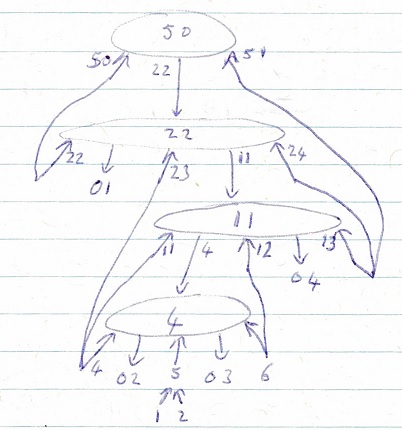
Algorithm recursive:
1 Do left response all way down chain at bottom
2 Wait for S-habit in middle
3 Do response on right of middle, if habit go to 1
4 Go up levels until at middle expected, go to 2
or until last goal – highest level
5 Wait for last S-habit
R-Habit stack at each point
50 –23 –51 50 trigger recognized and O1 output
50 –12 –5 –51 23 recognized and O2 output
50 –12 –51 5 recognized and O3 output
50 –51 12 recognized and O4 output
50 51 recognized if still conscious then transfer goal feeling to trigger.
Should put –51 right after 50 so sequence is
50 –51 –23
50 –51 –12 –5 one on end is always being waited for
50 –51 –12
50 –51
50
I should put in positive values for recognized left side.
50 –51 22 –23
50 –51 11 –12 4 –5 –1 if 5 is an S-habit
50 –51 11 –12 4 –5 1 –2
50 –51 11 –12
50 –51
50
If 51 was an S-habit of 34, 35 then start looks like: 50 –51 –34 22 –23
16th Jan. 2004
Now to actually create an R-habit need to do 2 responses in a row in concentration mode (practice)
Current interest levels
11 not habitualized result good
10 learnt result good
9 - not in use –
8 not habitualized result interesting
7 not habitualized result familiar or result permanent
6 learnt result interesting
5 permanent trigger
4 - not in use –
3 learnt a loop (learnt or not) result familiar or permanent
or one being done now
2 not habitualized result bad
1 learnt result bad
0 at end of LTM
-1 no interest – it’s a resulting stimulus

17th Jan. 2004 Loops causing a problem!
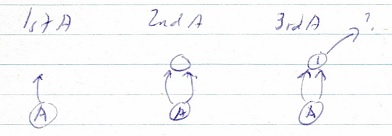
Double whammy on 3rd A – may be it should become active and be recognized simultaneously.
If it was A, B

Have to start a habit to ignore repetition! If then conscious do reflexive response.
What stages / states does an R-Habit go through?
1st it is a reflex A R1 B
2nd it is practiced and successful A R1 B success.
3rd it is used to achieve goal and if it succeeds a previous (one that was just practiced successfully) (No success causes stop processing) or one that achieved its goal then combine the two into R-Habit?
4th it is used subconsciously as part of higher level.
If 2nd is practiced and successful right after one that just achieved its goal could the 2nd successful one be combined with the 1st?
18th Jan. 2004
On 3rd execution B success not so important – so it can be the trigger for next R-Habit.
19th Jan. 2004 Loops
When it comes to loops a stimulus that comes in as a resulting stimulus should not be interesting enough to trigger a habit if it is the triggering stimulus for the current habit. You might say that because it has already fired (triggered) or is already being done it has lost its potency to trigger something else. But it still is recognized to complete the current habit.
These are some changes to handle looping and responses.
- In HABITMATCH: A loop only true if the loop it is doing has been learnt = HABITUALIZED (First) >0
- In HABITUALIZED: Test for storing a habit and if it is a loop habit mark result stimulus also marked as learnt and points to stored habit so it does not trigger recognition habit.
- Doing reflex turned on so the resulting stimulus does not trigger another reflexive output using next output value. This could be solved more naturally by assigning it an interest level between 2 and 3, because the result is the same as the trigger of the currently active habit.
Interest level on an unlearnt loop = 7 but =3 on a learnt loop. Which means, at least practice a loop to confirm it repeats but then have no interest in using it.
- Works better if not immediately interested in learning loops so interest level set to 3.
We learn orienting responses because they generate novel results – The result is on a different sense from the one that confirms the response.
- If most recent input matches end of LTM give interest level = 3 instead of 0 or based on just received input.
20th Jan. 2004 S-Habits vs. R-Habits
S-Habit consumes the resulting stimulus – the idea is to learn to ignore it. So it does not attract attention.
R-Habit should not consume the resulting stimulus – the idea is to reach the resulting stimulus (goal) and then be aware of what could be done next!
21st Jan. 2004
What about doing listening (S-Habits) the same way as R-Habits where listen is just another response (a null one)?
So A B becomes A B BC becomes B C
L L
A B C once learnt will become A C
L L #
S-Habits vs. R-Habits
The S-Habit hierarchy is one of recognition – the objective is to recognize something. Identify it, know it occurred. The R-Habit hierarchy is one of performance – the objective is to do something and reach a goal. We perform recognition because we attend to the expected resulting stimulus – the goal. But R-Habits tell us what to do to obtain results, in S-Habits we want to know the pair has occurred. But S-habits also tell us what to do – do a listen (nothing) – to obtain the result.
22nd Jan. 2004
Tried treating S-Habits as R-Habits but doesn’t work. You don’t recognize R-Habits as a unit – you recognize the trigger – you recognize the result, but not the pair.
27th Jan. 2004
See Adaptron test runs-1, 2, 3 and 4
28th Jan. 2004
If I have the following R-Habit structure

The habit stack is structured as when 15 A occurs
15 -16 11 -12 and b has been output waiting for B match at 12.
Get 12 and c is output and waiting for 16 c and stack is reduced to
15 -16
If we get M instead of B at 12 what is context that needs saving. If 15 A is already on LTM just need to save novel M. If we get B at 12 and get M instead of expected C the context to save in LTM is what has been done so far. (If it was conscious) If it was conscious then surely the stimuli have already been saved and when 16 C occurs we combine them again. So if consciously doing a R-S-R when we get the B that matches at 12 we need to do a SaveRHabit so B at 12 is put in LTM in case M occurs. No, we have to pay attention to B at 12 and actually do it.
1st Feb. 2004
New concentration levels based on whether a familiar stimulus is permanent or not. If not then it is still trying out possible responses for this stimulus and it can’t be used as a trigger stimulus for a recognition S-Habit / binon.
Not Permanent need to respond, which R-Habit is most interesting:
Result Result Result
Not Learnt rewarded Novel
Learnt punished Interesting Loop
Familiar
Rewarded / good Do First – Level 11 learnt or not – do most recent if > one.
Loop irrelevant. Can’t get a learnt and a not
learnt in LTM, will have always done last one.
Interesting 2nd - Level 9 Not learnt – do / repeat
3rd - Level 8 Learnt – do / repeat (subconsciously)
If a loop –already in interesting situation – try a new response
Familiar 4th - Level 7 not learnt – do / repeat
- Level 3 Learnt - try next / new response
Punished - Level 2 Learnt or not - try next / new response
But if not permanent and only ever perceived once then nothing was done so can’t repeat it (nothing) – so try next / new (first) response.
12th Feb. 2004
If we start a subconscious R-Habit what do we then do consciously? Whatever attracts attention? Starting with the highest interest recall first.
17th Feb. 2004
Simple principle if familiar stimulus has been learnt and it is a rewarding or interesting R-Habit then start it subconsciously and any S-Habit learnt start subconsciously. All unlearnt do / repeat.
19th Feb 2004
Stimuli matches are consumed / used and ignored by S-Habits.
If the S-Habit is subconscious the expected stimulus that matches is used but is still available for conscious attention. If a conscious S-Habit uses the stimulus match it is consumed and is not available to trigger any further habit – but the collapsed stimulus is available as a different stimulus.
A collapsed / recognized subconscious S-Habit is put on the S-list (it might be new, it might be familiar). It might be needed by an R-Habit.
If an R-Habit uses a stimulus match / recognition
- if it is subconscious the match is still available for consciousness
- if it is conscious the match is still available for consciousness.
A completed R-Habit is removed from Habit list only if its resulting goal stimulus remains to attract attention.
20th Feb 2004
There are two ways a stimulus can be used – to match with the next expected stimulus of a habit or to trigger the start of a new habit.
All R-Habits must be started consciously! An unlearnt one needs practising and is done consciously. A learnt one can be done subconsciously.
I’ve been building Adaptron based on the principle that a habit must be practiced once before it becomes a habit. I then mark it as habitualized / learnt and this has an effect on its future interest in being repeated.
Question: Why does it have to be repeated to be “valid”? Isn’t it “valid” the 1st time done? Why must an R-Habit be practiced? Isn’t its first occurrence good enough?
If no need to practice a habit then on second performance the response is done subconsciously! It’s not done to validate it or learn it – It is done only if the expected result is interesting enough.
So new interest levels for familiar stimuli are based on result.
Result Level – Not permanent – need to respond
Good 10 do/repeat
Interesting 8 do/repeat
Familiar 3 try next
A loop 3 try next
Punished 1 try next (avoid)
No Response involved 3 -> 4 try next
Permanent – S-Habit
Good 5 \
Interesting 5 > do / recognize
Familiar 5 /
A loop 3
Response involved 0
24th Feb 2004
The idea behind R-Habit execution is that we start the habit consciously based on the interest level in the goal stimulus. We then perform the response subconsciously including the recognition of all the intermediate stimuli. The goal makes itself conscious only if it is interesting enough in itself or is associated to something interesting. While the steps in the R-habit are being done we can attend to the stimuli (with no other responses done / started) or with other responses started (which may interfere with the subconscious R-Habit being done) or can think (which takes up stimuli recognition cycles).
Interest
Level Learnt? Result Permanent
11 Not Learnt Good No ]
10 Good No ]
9 Not Learnt Interesting No ] Repeat (these 5)
8 Interesting No ]
New 7 Not Learnt Familiar No ]
2 6 Not Learnt Fam./Int./good Yes ] Do Subconsciously (these 2)
1 5 Fam./Int./Good Yes ]
6 4 Not Perm&Not Response No
5 3 Learnt/Not Perm/Fam Not Interested Loop&Perm
4 2 Not Learnt Bad No
3 1 Bad No
0 End of Memory
25th Feb 2004
Change Interest level on subconsciously done familiar permanent stimuli to 1 and 2.
26th Feb 2004
Kinesthetic stimuli are used as feedback for responses because all human responses are muscular. It is the other senses such as sight and hearing that produce novel and rewarding stimuli. This allows for actions and hierarchies of actions to be done with feedback subconsciously while we attend to other external sense stimuli consciously and not have to monitor the action (be conscious of kinesthetic stimuli) e.g. talking – word formation uses kinesthetic and touch feedback while we are conscious only of the ideas (expectations) of the words we want to say. Each word heard (when spoken by somebody else) forms a single S-habit / binon and we also hear our own spoken words as such. The idea of them triggers the speech act.
27th Feb 2004
I have concluded that thinking only recalls stimuli across associations in which some action / response has taken place – does not recall the content of an S-Habit by decomposing it into 1st and 2nd stimuli.
1st March 2004
Think before action – so after finding most interesting association to familiar stimulus think about it and then decide whether to do it or not.
2nd March 2004 Things to do
1. Simultaneous binons – more than one sense
2. Parallel outputs – more than one actuator/ muscle device
3. Thinking loop / repeat – exploring experiences
4. Good and Bad stimuli
5. Perform looping R-Habit subconsciously
As I run Adaptron test cases I end up asking many fundamental philosophical questions – I think I should write them down and number them and capture the answers when I have them.
Question 1. Does a habit get performed at a particular level of concentration and only get interrupted by a familiar stimulus triggering another habit with a higher level of interest? Or does the result/goal stimulus have the interest level and when achieved – reached will be paid attention to at the original interest level unless another stimulus is more interesting?
3rd March 2004
When an R-Habit is active and conscious (the one being done consciously) and a new R-Habit is started then the previous one becomes subconscious. It will fail when it does not get an expected stimulus (because one of its resources / devices / muscles is used for something else). Else the subconscious one will continue to completion.
An interesting human behaviour trait is someone who has learnt how to do something but not necessarily the most efficient (least number of steps) way. Every time they need the result / goal they continue to do it this way. Then someone comes along and shows them a more efficient way to do it. Maybe those extra steps were totally non-productive. Thinking should allow/provide for a mechanism that makes the extra steps conscious and recognized as not necessary. The extra steps can also become a superstition.
Conscious R-Habits consume their intermediate resulting stimuli except for the last one (goal) so that these intermediate stimuli don’t trigger parallel identical sub R-Habits.
4th March 2004
Let us say that a primitive stimulus such as yellow has become permanent – it no longer triggers any action / reaction – it is combined with other permanent stimuli such as shape to form stimulus habits as banana which may trigger actions.
Question 2. How do we now perform actions whenever we see yellow in a context discrimination test? Since there are effectively infinite actions or action combinations that can be done – having tried them all before making a stimulus permanent is not a logical strategy – Also this will not work for simultaneous stimuli because no action can be done between stimuli. Sequential stimuli must be able to form – S-habits (relationships) only when no conscious action done between them. So on 1st response - a reflex, it’s conscious and we get the goal stimulus. On second performance the response is like an orienting response (it’s done subconsciously) so that we can experience the 2 stimuli sequentially without a response between them. Maybe there are 3 levels of doing an action.
1/ The original reflex which learns the result
2/ Repeat the action to get the desired result consciously, which allows it to be combined with any previously performed R-Habit.
3/ Perform the action to get the desired result subconsciously so no record is kept of action done and result can be combined with trigger stimulus to produce relationships / S-Habit (But no record of it being done by itself?)
Or maybe the solution is to use kinesthetic stimuli for action feedback and never form relationships out of them. This idea holds true. Kinesthetic stimuli have no novelty to them and are only produced by action. What if someone else moves your arm? Then relationships are formed from all the other simultaneous sense/features. One of these can trigger the action to achieve a result of one of these stimuli and temporal pattern recognition can take place between these stimuli in parallel with the action habit / sequence.
5th March 2004
You can be doing something and all of a sudden you find yourself in a room and ask “what am I doing here?” You have lost the train of action – it’s no longer conscious – you have to look at what you are carrying or go back to where you came from to remind yourself of what you were doing. Similarly it is easy to interrupt what you are doing by seeing something that triggers a different course of action. This means we tend to use the real world and the experiencing of it to keep us on course as to what we are doing. Maintain the consciousness of the current sequence (R-Habit).
19th March 2004
Maybe STM is like another sense. There are responses to output to it and stimulus matches cause attraction of attention.
21st March 2004
If reflexive response then use the immediate resulting stimulus as goal – don’t start recognition of stimulus (composite) based on goal stimulus. If response not done subconsciously then concentrating on goal stimulus – paying attention to that sense/feature and thus do not combine it with the next one! If subconscious response then combined sequential resulting stimuli are recognized / attract attention. So conscious concentration – does not combine sequential stimuli?? (while doing R-Habit??)
23rd March 2004
We only can do one thing at a time. I.E. we are only conscious of one action or thought at any one time or – we are only intentionally / consciously paying attention to one habit at a time. But this does not mean we are only consciously processing one habit at a time. All habits which have the same triggering stimulus are active and being processed all expecting their associated resulting stimulus. The stimuli received to date - the context must match all these active habits. As long as one of these active habits succeeds in getting its next expected stimulus the the others can die.
24th March 2004
Question 3. Should the goal stimulus resulting from a reflexive response after it has been attended to, be available to trigger another response, reflexively or from an unlearnt R-Habit that needs practicing? It is not available to trigger a sequential recognition S-Habit because it has been put in LTM as a result of attending to it. If it is not used to trigger another response then with only one sense/feature it will never collapse R-Habits because there will always be 2 stimuli between any 2 responses. With 2 or more sense/features then one sense/feature (kinesthetic) can be the attended to goal stimulus while the other sense/feature can trigger another response.
Maybe what can be done after obtaining / attending to the goal stimulus depends on whether the stimulus resulted from a reflexive response or practicing a known but unlearnt response (one not yet repeated)
1st response 2nd response
Reflex unlearnt
Reflex Reflex - maybe not allowed?
Unlearnt Reflex
Unlearnt Unlearnt
When the 1st response is a reflex there is no expectation of a result and no feeling of success based on result.
Question 4. What if an expected result has become permanent? Does the R-Habit attend to the permanent stimulus result and it is not combined / collapsed? And it is not used as a trigger for a response (i.e. permanent – recognition only)? Yes – must pay attention to just what R-Habit expects even if permanent. Resulting stimulus should not be sequentially collapsed and not trigger any action. However if the response was reflexive there was no expectation and it can wait for permanent stimulus plus next stimulus to combine to produce non-permanent resulting stimulus (see Adaptron test run-7 29th Mar, 2004 )
Question 5. Should an unexpected yet familiar result after a response match with past experiences? Or is it expected if it has a match in the past? For S-Habits all experienced results are expected and the one that occurs causes recognition of binon.
26th March 2004
Familiar stimulus A – if no expectations then try reflexive output – OK – no surprise.
Stimulus A – if has expectation B, C, D as long as one is still not proven – listen expecting it. If get a new familiar one, record it. If get B, C or D then recognize AB, AC, AD and that is just like A in this scenario.
27th March 2004
Stimulus A – if has expectations B, C D and all are proven (learnt) then try reflexive output – No. store A in LTM because it forms a novel binon! – surprise – unexpected.
30th March 2004
Once we have tried and practiced / confirmed all possible responses for a given primitive stimulus we want to stop trying again. Current implementation marks the stimulus as permanent. But in humans we don’t do this. We try new responses if the stimulus is boring. Need to define boredom more precisely – need to rethink the permanent concept too.
31st March 2004
See Adaptron test runs-1 and 2
1st April 2004
A repeated stimulus is boring because on its third occurrence in a row the expected result is the same as the stimulus. The ideal behaviour is to start a recognition habit to recognize it and ignore it, but should explore all the possible responses before ignoring it.
2nd April 2004
So I have it recognizing a loop on the third occurrence of the same stimulus but now it has 3 occurrences in a row which gives 2 locations in a sequential memory where it (the pair) occurs. If it was neurons a new neuron is not created to recognize the pair – same one is used.

In reality you ignore it after 3 times and have no recollection of how many times it actually occurred unless you count them (relate occurrences to numbers) so why not refuse to record it the 3rd time in memory and use 2nd occurrence in memory as trigger for response (reflexive)?
9th April 2004
Question: Should a long ago unproven, unhabitualized action which had a result that has never occurred again drive Adaptron on to repeat this action in this same setting – trigger situation just to see if it might occur again? Even when it has received a different result from this action many times since? It’s like gambling where one time long ago a jackpot was hit and now it continues trying just in case it gets that “rewarding” event again. In this case the reward is the practice/confirmation/proving of past experience/ R-Habit.
Things to do next:
1/ Simultaneous binons – more than one sense – will drive need for subconscious S-Habits.
2/ Simultaneous output – R-Habits - will take advantage of subconscious processing to continue actions.
3/ Thinking – longer chains of thoughts directed by interesting results.
4/ Good and Bad stimuli – motivated repetitively
5/ Processes repeated / looping R-Habits subconsciously
Priority Try 4/ then 1/
12th April 2004
Yesterday I had the idea that a possible way to handle repeated stimuli was to recognize the 2nd occurrence familiar and the pair – S-Habit binon with the two of them in it as familiar as well – as though it has been practiced / learnt then the 3rd occurrence will result in boredom and a reflexive response.
14th April 2004
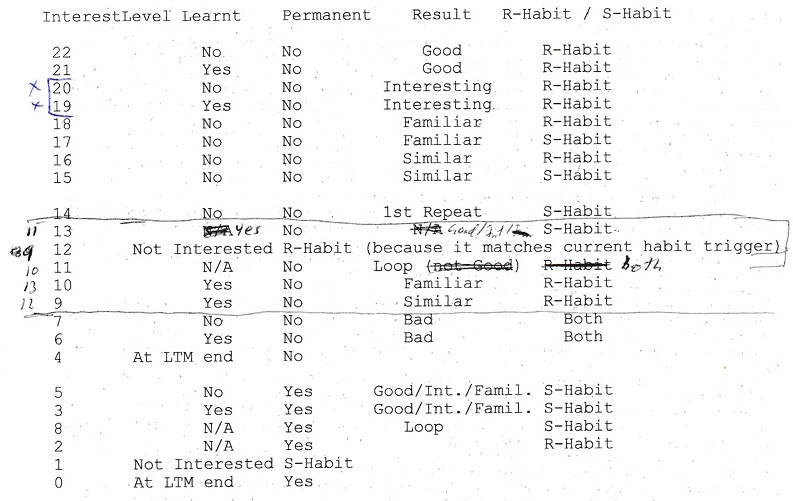
16th April 2004
While consciously executing an action Habit the series of stimuli are constantly changing. Question: Do subconscious recognition habits recognize and consume this series of stimuli so we ignore them and only concentrate on the ones the action habit needs? I believe yes! S-Habits do not stop while an R-Habit is executing (subconscious S-Habits that is !)
30th April 2004

2nd May 2004
When we think about something we need to buy at the store the idea of this thing gets attached to the idea of the store. When we are next at the store the idea of the thing comes to mind and we remember to buy it. Or we remember that there was something we should buy but can’t remember what it was. Several observations possible 1/ the actual store must trigger/match up with the idea of the store. 2/ the idea of the thing must be associated with the idea of the store, and others.
Ideas/thoughts/expectations don’t have expectations. Thoughts don’t get done in this sense. The idea of (concept) “yellow” or “above” does not have an expectation, neither does “soap” – unless you see it. Then it has some associations - expectations – or you think about soap then it matches the soap experience which has associations -expectations. But we “learn how to think” – how is this possible if thoughts have no expectations? Need to compare actual result with expected result to learn!
I believe we have longer “trains of thought” as a result of having a much larger base of experiences and associations which to think about – but we do not learn any new thinking techniques / steps / style.
“Out of sight – Out of mind”
27th May 2004
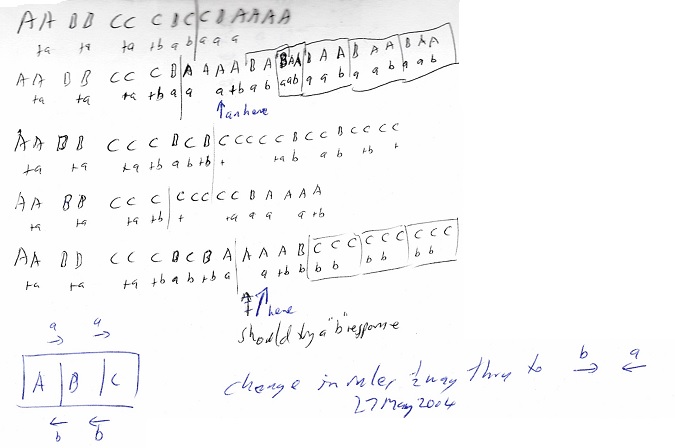
28th May 2004
A clearer definition of boredom is necessary. Currently, if the second occurrence of the stimulus A occurs immediately after its first occurrence (which was put in long term memory because it was novel) the first occurrence is marked familiar so that the binon AA is familiar, interest level is set to low so first occurrence is not executed (it’s at LTM end so would not want to execute it) and so it is boring and a first reflex response is produced. The second A had no expectation so what else was there to do but try a response. But what if A had occurred previously and its expected result is B. Now later an A occurs for the second time and we start a recognition habit expecting the B. But instead another A occurs. This is the third occurrence of A and it has now occurred in a row, surely this repeat should be seen as boring and a reflex response produced?
Test with AABCDBB <– B is boring.
+a +a

16th June 2004
Boredom is all about recognizing repetition. It could be two stimuli the same following each other without an in between response either executing or not an S-Habit or with an in between response either done reflexively or by doing an R-Habit. The 2 stimuli that are the same must be conscious. Borden is all about avoiding repetition by performing a response until all have been tried and then the stimulus becomes permanent.
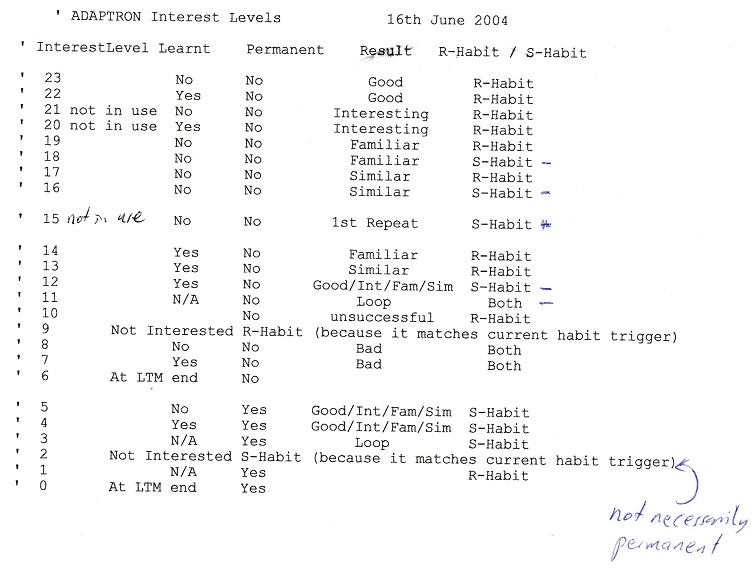
30th June 2004
See the 2004 Scientific Research and Experimental Development (SR&ED) tax credit claim.
Details about the Canadian Revenue Agency’s SR&ED tax incentive program are here.
8th July 2004
We are conscious of our most recent stimulus or thought and this is always being compared with the next stimulus or thought to provide a same / different feeling. This is why we need to switch our attention backwards and forwards between 2 similar pictures / sounds / tastes, etc. to compare them to identify what is different. If the two stimuli are the same we perform a response to obtain a difference or ignore the loop / repeated stimulus and pay attention to something else.
Similarity is used in recall to find similar experiences. This is recognition and if no match is found we know it is novel. This novelty attracts attention. But we don’t use similarity with LT memory / experiences to perform a response to obtain a difference – we use this similarity as familiarity to determine what to do.
Boredom caused by repetition of a stimulus will result in a reflexive response if we are doing an S-habit or R-habit as a result of curiosity (trying to learn something) but not result in a reflexive response if we are doing it as a result of wanting to (due to good expectation).

Loops detected and acted on:
– When store stimulus mark previous repeat familiar.
– Interest level 11 R & S-habits novel & familiar
– Interest level 3 S-habit permanent novel & familiar
– R-habit gets result = trigger – do reflex RLoop
– S-habit gets result = trigger – do reflex Sloop
– Interest level 15 1st repeat S-habit
17th July 2004
Overall Algorithm given some simultaneous stimuli:
1/ Process any novel stimulus
2/ Else process any habits expecting to consume / ignore some stimuli
3/ Process habits that got unexpected result
4/ Pay attention to most interesting familiar stimulus
5/ Think about it – what might it result in
6/ If it’s a loop, do reflexive response
7/ Else start habit based on it
8/ Start any other recognitions habits - subconscious
The context of the currently executing habit could be put at the end of LTM so it can be matched with stimuli to recognize any repeat / loops – STM processing.
At some point after I have got simultaneous stimuli working I should make the internal feelings (a loop, same, similar etc) into a source of stimuli. Right now the action resulting from a loop is to do a reflex response. It should be able to learn what to do after this emotional feeling.
18th July 2004 S-Habits vs. R-Habits
We possibly have two different types of thinking based on S-Habits or R-Habits. A trigger stimulus that matches an R-Habit trigger has expectations of the result – the next stimulus in time order and the interest in doing the habit is based on this result (expected).
A stimulus that matches an S-Habit trigger has an expectation of the next stimulus but that implies the recognition of the pair – binon – so an expectation of the S-Habit and it is the feelings that determine the expectation as in Notes pg. 79 9th February 2003, where 2 is to do nothing – just listen.
19th July 2004
Right now Adaptron stores in LTM the unexpected stimulus from an executing conscious R-Habit without doing any further recognition of it. And Adaptron doesn’t store in LTM the expected stimulus from an executing conscious R-Habit – it uses it as a trigger stimulus to recognize what might follow. This does not seem logical. I think it should depend on whether the R-Habit is conscious or not. The purpose of doing a response the first time is to avoid boredom. The purpose of doing it the second time is to prove it / learn it. Here it needs to be conscious and the result needs to be consciously attended to in case it triggers another R-Habit or S-Habit. (Seems to be what it does. Maybe the first thing is wrong.) However, if a learnt R-Habit is being done it should be done subconsciously and a pattern match with the resulting stimulus should be the end of the habit execution. Storing the unexpected result doesn’t allow any further recognition to take place.
20th July 2004
Fear comes from expectation of bad but it also can come from not knowing what will happen next, i.e. a novel situation, if in the past such situations have produced bad results. The fear feeling has to be associated to the feeling of not knowing which always occurs in a novel situation.
Most recent stimulus match only:
I thought of a different strategy for handling what to do next after a familiar stimulus occurs. Obviously the first time it occurs it is novel and all that can be done is to store it in LTM and follow it with its resulting stimulus. When it occurs a second and third time the current strategy is as long as there is one past experience that is unlearnt for this trigger then do them all, hoping we will get one of the unlearnt ones. And if they are all learnt then we are bored and it’s time to do a reflexive response.
Then when the resulting stimulus occurs if it is unexpected we record a new binon – an unlearnt experience. If it is an expected result we now have a learnt or a relearnt one and if it is the same as the trigger we have a loop so do a reflexive response.
The new strategy is based on the principle that only the most recent occurrence of this trigger stimulus is worth learning – it represents the most current understanding of the environment which is presumed to be static and deterministic. If the resulting stimulus is different from the most recent experience the environment’s rules have changed or there is some other aspect of the trigger stimulus that has not been recognized. (works for simultaneous S-Habit / binons).
So given a trigger stimulus if the most recent one experienced is unlearnt then do it and all similar past ones in case they occur. This works for R-Habits too – the past ones must have / do the same response. If the most recent one experienced is learnt we are bored and need to explore so do a reflexive response.
If the result is an unexpected stimulus then we have an unlearnt R-Habit which will be the most recent. If the result matches one expected but not learnt then this becomes learnt as the most recent. If the result matches a learnt expected one in the case of an S-Habit we recognize the pair as a new stimulus. In the case of an R-Habit the learnt expected one is continued as most recent. I don’t think you can be doing a learnt experienced one because if it exists in memory it must have been done the last time most recently and a different response tried.
If the result is the same as the trigger we have a loop and immediately do a reflexive response.
22nd July 2004
Thinking can result in us doing {what was mentioned in the 2nd to last paragraph of 20th July 2004} but that’s okay. We just repeat the most recently learnt response in order to accomplish what thinking has predicted.
23rd July 2004 Internet access
I thought of a great way to provide Adaptron today. Rather than sell the source code or compiled version, I could set it up on the Internet so people could play with it. They would specify number of senses, range / resolution of values per feature per sense, number of output devices and range of responses per device. Then they would provide a stream of stimuli and Adaptron would provide a stream of responses. Some example environments would show them how to do it and what Adaptron could do. The first so many (10,000 for example) events would be free and then I could charge for its use thereafter.
25th July 2004 S-Habits vs. R-Habits
Once again I tried to use sequential recognition binons to replace R-Habits. It didn’t work as nicely as before. (See 22nd January 2004). Now realize that S-Habits are learning how to recognize and R-Habits are learning how to do / behave – two different types of learning. And two different types of thinking??? 18th July note probably should have said two types of learning!
Stimuli are consumed / ignored by subconsciously executing S-Habits and R-Habits. But the more specific idea is that past experience matches / recalls of a stimulus do not interrupt the mind if they match the trigger stimulus of a currently executing habit – but they stay available if they match a result stimulus of a currently executing habit.
29th July 2004 Good and Bad
Good and bad and neutral feelings associated with stimuli need to be separate from familiarity and novelty. A stimulus can have one of each.
10th August 2004
Need to make good and bad and their expectations predominate over novel and familiar for driving learning. And thinking should still be done even if there is a novel experience that needs to be learnt (repeated).
18th August 2004
As a result of experiments, especially with punishment, it looks like the expectation of good and expectation of bad are associated with stimuli permanently as their feeling if precursors to pain are to be feared even if they have been experienced with no pain and if stimuli are to continue to be valued as good even though they have not most recently been rewarded, e.g. money.
Another decision I have made but not documented is that binons that have a rewarding or punishing result are marked as learnt and do not need to be repeated such as novel binons.
19th August 2004
I’m calling any stimulus that has been associated with pleasure “wanted” and any stimulus associated with pain “feared”. So money is wanted and poisonous snakes are feared. The labeling of wanted or feared is a learnt association. Thus the first time pleasure or pain occurs after a stimulus it is novel but after the second time has been learnt and the stimulus is wanted or feared. It can be unlearnt but I haven’t thought about the mechanism yet.
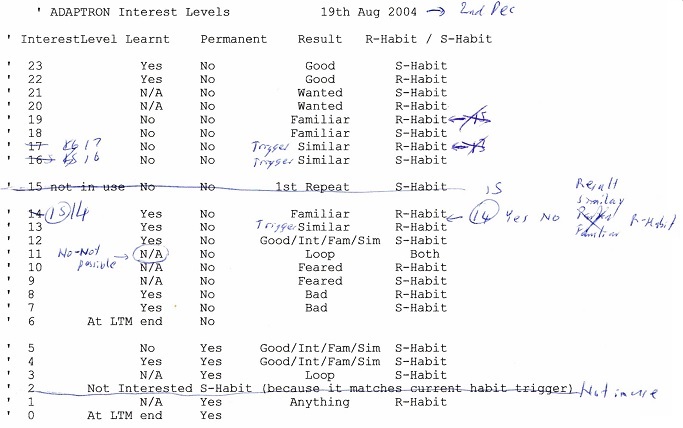
20th August 2004
Psychological reading about learning points out that the change in pleasure / pain can reward / punish. Running away from a feared poisonous snake decreases fear – positive change which rewards.
Frustration – not getting an expected reward – is also a demotivator, just like pain.
Feeling of success is rewarding – getting the expected result.
31st August 2004
Change pleasure / pain to a stimulus with numeric value rather than yes / no or on / off.
1st September 2004 12:00 See also: 13th January, 2005
Assuming pain – X - and pleasure – Y – stimuli have an associated emotional feeling value of -99 and +99 then when stimulus A is followed by Y:
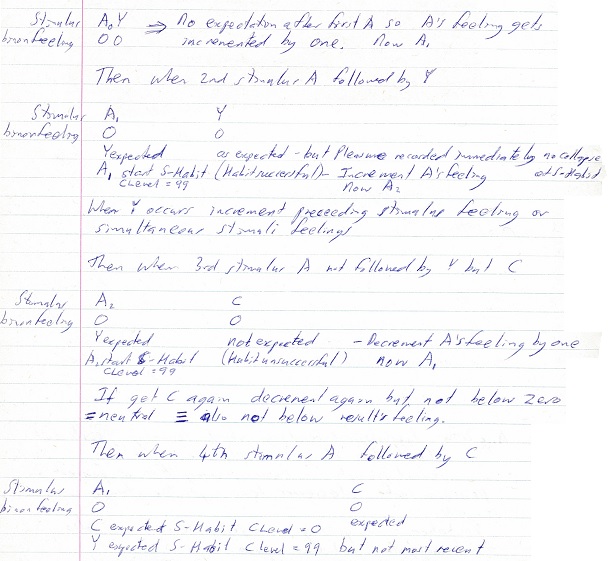
C was not unexpected – this fact cannot be used to decrement A’s feeling. How about using relative feelings of result to trigger and decrementing trigger if result’s feeling is lower? Similarly increment trigger’s feeling if result’s feeling is higher but never decrement it above the result’s feeling and never decrement trigger’s feelings below result’s feeling.
If result’s feeling is negative and less than the trigger’s feeling then decrement trigger’s feeling (maybe by 2 to get faster extinction) until as low as result’s feeling.
If result’s feeling is negative and greater than the trigger’s feeling then increment trigger’s feeling (result is less negative).
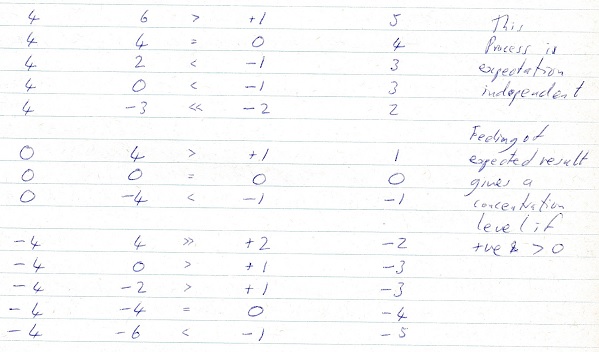
Question: When does A C pair get recognized as a successful S-Habit and collapse? Do both A and C have to have neutral feelings? Probably Yes. Collapse occurs because we don’t need to distinguish each stimulus as separate with separate properties (feelings or actions to be done). Recognize as a pair as last resort because things depend on the pair not on either stimulus individually.
Now consider a response between trigger and result – will the same process work. I think so for those situations when we actually do the R-Habit. This only takes place if the feeling of the expected result is zero or positive. When the feeling of the expected result is negative we will not repeat / execute the R-Habit. Will we also try a reflexive response? I think so, yes! Or will we first try doing nothing (listening) and then if this doesn’t work we have an S-Habit with a negative feeling of expected result.
In the case of the S-Habit when the feeling of the expected result is negative we may be stimulated into trying a reflexive response because we want to avoid the expected result.
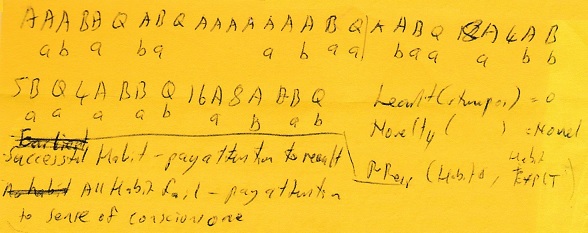
4th September 2004
The purpose of Adaptron is to obtain pleasure and avoid pain. But once pleasure has been obtained the drive level to obtain pleasure does not diminish. It is as though it is insatiable, unquenchable. This differs from man’s thirst, hunger, etc. drives which can be satisfied for periods of time.
5th September 2004
The set of feelings that are derived from novel versus familiar stimuli and the learning that results from the drive of curiosity are”
Anticipation – of success – before doing – Hope
Success - familiar expected result – after doing
Frustration – familiar unexpected result – after doing
Surprise – novel - ? – unexpected result – after doing
Expected failure ? – of failure – before doing – would not do it
Expected novelty ? - of novelty – before doing
Expected failure – anger / fear
Expected novelty or surprise – interest
Bored – all habits learnt - before doing – try new and expected novelty
Failure is getting a repetition – a loop – results in frustration.
Surprise comes from an unexpected familiar result that is not frustrating, not a loop (which is being avoided)
So full logical sequence of doing something with feelings added.
1. Trigger stimulus – familiar – multiple experience matches
2. Most recall recent experience – expected result and expected feeling
3. Think about result – recall its consequences
4. Think about expected feeling ?
5. Compare feelings ? and decide to do it or not to do it
6. Do it as habit – expect result – successful
7. Result stimulus = expected by habit – success – habit is learnt and can be done subconsciously next time
6th September 2004
What to do next? See 9th April.
1. Implement and test more complicated emotional feelings.
2. Work on discrimination – generalization / specialization
a/ turn on kinesthetic or
b/ use a second external – non kinesthetic sense / feature
c/ investigate a continuous feature where differences are comparable
3. Make avoiding repetition more important than permanent.
4. Store emotional feelings from curiosity / exploration / novelty – consider them a second source of stimuli
5. Subconscious recognition (S-Habits) – needs 2 or more stimulus sources
6. Subconscious action (R-Habits) – needs 2 or more devices
7. Make learning of familiar slower – needs 2 repetitions of success to learn
8. Longer chains of thought
9. See 12th January 2005
Nostalgia involves the recall of feelings! – reminiscing about the feeling
7th September 2004 Simultaneous Binons (see 8th & 9th January)
Given that we generalize first and only specialize when we have feedback from doing the first time Aa occurs we store the combination as a stimulus. Then if Aa occurs a second time it is an exact match to this – not only does A match with similar, a matches with similar but Aa matches exactly and an exact match is more useful than a similar one so Aa is recognized as the second input and this is a loop so a reflexive response should be generated.
But when the input becomes Ab due to response of a ‘b’ we must recognize the changing stimulus. Attention automatically attracted to the change rather than see Ab as a new binon. This happens through the execution of subconscious recognition habits that only ‘speak up’ when they get an unexpected stimulus. If a subconscious habit completes it has ‘consumed’ the stimulus – it is not so interesting (expected).
*! What has to attract attention is the largest combination of stimuli that have changed or are novel which contains no familiar or unchanged stimuli. How can habit execution (subconscious) do this? !*
With sequential binons it says when you have experienced the first stimulus you can expect the second stimulus. A simultaneous binon says when you have either one of the stimuli you can expect the other. In either case if the unexpected occurs then you pay attention to it. In both cases if the expected occurs you have recognized the binon – first time you have learnt it, second time (being done subconsciously) you don’t put result (the binon) on the S-list. Or it is there but its interest level is low. Need a novelty rating scheme and novelty of a stimulus is determined by executing habits.
8th September 2004
To address the novelty rating of simultaneous binons and stimuli give a novel non-binon stimulus a rating of 2 for novel and 0 for familiar. For a binon add the novelty of the 2 source stimuli together and divide by 2. If both sources are novel it will also be rated as 2. If neither are novel it will be rated at 0. If one is and the other not it will be rated at 1. Not as novel as a stimulus or binon rated at 2.
9th September 2004
A better but similar strategy is to do a habit match on the two source stimuli just like we do on sequential stimuli. Then look at the resulting relationship. Does it get an expected simultaneous binon or is one of or both source stimuli novel. The algorithm would work something like:
Get first stimulus – if it is familiar then start multiple S-habits expecting possible second stimuli
If any one of second stimuli are same as actual second stimuli then have (expected) familiar S-binon
If no second expected stimuli are same as actual second then if actual second is novel then have novel stimulus and partially novel relationship
Else if actual second is familiar then have novel relationship
If first novel then check second
If second novel – novel relationship
If second familiar – have novel stimulus and partially novel relationship
10th September 2004 Similarity / Generalization
Now that it is recognizing exact matches and partial (similar) matches on relationships
Q: It begs the question – when can similarity be used as though it was the same and when not?
For triggering a habit it would seem reasonable that an exact match to the trigger works and only if there are no exact matches then a similar match would be used. For matching a goal / result stimulus to an executing / active habit an exact match will work. But will a similar one be sufficient?
An example of a similar trigger starting a habit is: You see a snake and become frightened. You have learnt the habit based on any snake- like animal. You have a generalized trigger. Any long, scaly, round animal will trigger the fear. Even just seeing the tail of a dead one might trigger it for an instant. Thus a similar trigger stimulus works on the habit, i.e. we generalize first and then learn to specialize. A child sees a cow, parents say “cow”. Child sees horse and says “cow” because some of the features are similar. This strategy provides a wealth of possible responses to try in specialized trigger situations and is a reasonable strategy. Of all the partial matches to the trigger use the habit that is closest to same – most similar.
Now what about the result? What if the trigger was an exact match but the result only partially matched the expected result? The expected result must have been a complex stimulus! I think whatever part is the most same we consider the new result. It will be more specialized than the previous result.
In both cases we have not learnt the original habit – we have got a more specialized habit that needs repeating to be learnt. If the trigger or result becomes too specialized and the habit fails then the more general one still exists. But if either partial trigger or result is involved and previous experience is not marked learnt then may as well not be doing habit if partial trigger match. Just use previous habit as source of potential responses to try.
A partial match to trigger stimulus is only going to give a possible response to use the first time the current stimulus occurs by itself because after that the current stimulus will be in memory and an exact match will exist. Maybe it’s worth using any partial match responses before making stimulus permanent. Read 28th August, 1998.
14th September 2004
Q: How is the execution of a subconscious S-Habit to recognize a sequential pair of stimuli meant to decrease its novelty? Make it familiar and therefore stop it from interrupting /attracting attention. Does the habit execution “use up” the result stimulus or does it create the S-Habit and put it on the S-List but marked familiar, allowing other novel stimuli to attract attention.
Unexpected
As with simultaneous S-Habits you can’t notice the unexpected combination of 2 familiar stimuli unless you have a habit that is monitoring the expected and “speaks up” when a familiar but unexpected stimulus occurs – thus a new sequence!
15th September 2004
Thus when a subconscious S-Habit completes it should not put its result on the S-List. But then it would not be available for other habits to use. It should put its result on the S-List but only be available for other subconscious S-Habits to use! No conscious habit should be able to use it. It should not be attended to in the search for what stimulus attracts attention unless there is nothing else to attend to.
17th September 2004 Conscious / Subconscious
There’s only one conscious habit (if any) being done at any one time. It is the one we are practicing in order to confirm an S-Habit, change it from novel to familiar, or it’s the one we are doing to achieve the good (expected) feeling of the result.
Since there is only one conscious habit there is only one conscious expectation and expected feeling at any one time.
Conscious / Subconscious habits
If we have reacted reflexively then no habit is conscious – we either reacted to repetition (a loop) or boredom (all habits familiar / learnt or not good expected or no fear / bad to avoid).
Q: Is it possible the conscious habit is a leftover subconscious habit that is continuing and we become conscious of it? I think so.
There could be many subconscious sequential habits being done simultaneously. They are being done to ignore all the familiar stimuli and notice any unexpected ones. Each one gets processed against available stimuli. A stimulus can be reused as the one expected by multiple habits. But its match gets marked as used as trigger if it is a trigger for a continuing habit. A stimulus so marked is already in a habit so should not be used to start any new ones.
Any completed subconscious habit gets placed on S-List as recognized and familiar. All subconscious habits that get started are either learnt or unlearnt. If an unlearnt one completes the stimulus on S-List is marked novel and it attracts attention. If a learnt one completes the stimulus on the S-List is familiar.
If the conscious one succeeds and it was unlearnt then its novel result will attract attention. If the conscious one succeeds and it was learnt – being done for reward – then the feeling of the result is compared with the expected feeling and the habit’s feeling adjusted appropriately. But if being done because it was a continuing subconscious one that has become conscious and it succeeds then its result is on the S-List as familiar and competes for attention like all other S-List stimuli. If a continuing conscious habit is available then a new conscious habit can only be started if it is more interesting than the current one. All other new habits are done subconsciously. A new conscious habit can replace a continuing one if the continuing one is doing a learnt habit but the new one needs to repeat an unlearnt habit. So each habit when started needs to have the expected feeling recorded with it – Novel expected (unlearnt), familiar expected (learnt). When the conscious one fails to get expected result then we look at subconscious habits. If any succeeded we may have a novel or familiar stimulus on the S-List to be used for a new conscious habit. If none succeeded or are continuing we have surprise and we dump context – paying attention to previously conscious one’s expected stimulus sense. If only a subconscious habit is continuing then make it the conscious one.
If the conscious habit is an R-Habit it is only being done to get good result or learn R-Habit. A learnt R-Habit is always started and done subconsciously. This assumes no good expected result.

Idea – use R-Habit structure to record S-Habits.
19th September 2004
HZD pointer is meant to point to most recent / last place in LTM where the stimulus was experienced. This should include when it is experienced as a resulting stimulus of a habit! Even if it didn’t trigger another one.
26th September 2004
When we do things subconsciously it is started by the trigger stimulus followed by an expectation of result plus expected feeling. These get started in memory so we can recall what we did and why we did it. These may act as the material for problem solving. We have an image / idea of what we want and a current context and this matches the experience. What we want matches the expectation and current context matches the trigger stimulus. These two may be stored as a simultaneous binon so order is not so important and we don’t have to match backwards against a sequential binon.
I should investigate how well simultaneous binons would do in recognizing a 2-dimensional array of sensors such as in vision - visual stimuli.
29th October 2004 R-Habit Conscious / Sub-conscious
When a conscious R-Habit succeeds in getting its expected S-Habit result then the LTM entry for it is updated. If it fails then we pay attention to expected result’s sense / feature. When a subconscious R-Habit fails it just dies and does not attract attention. It was on Habit list just in case get a previously learnt (but more recently replaced) R-Habit result. If it succeeds then the conscious one must have failed and not continuing – which implies the subconscious one was expecting a different result from the conscious one.
Good idea: Or if the conscious one succeeded or is continuing then all successful or continuing R-Habits are dead or continue but do not attract attention.
A subconscious habit fails because it gets an unexpected result stimulus. It may also have been on the Habit list because it was started consciously and let run subconsciously – not just to repeat old – replaced learnt R-Habits. If it succeeds or continues the conscious one also may have succeeded or is continuing using different sense / features for the resulting stimulus. Don’t need to start parallel subconscious R-Habit to repeat old – replaced learnt R-Habits because if conscious R-Habit fails it pays attention to expected sense / feature. ???
If the conscious R-Habit fails should an old – replaced one being done subconsciously come to attention, what is the advantage? If it was previously unlearnt, it is now learnt – otherwise it would need to be relearnt – as though it had not happened previously.
But the conscious R-Habit is being done because it needs to be practiced – learnt. A learnt R-Habit is not done consciously – it already works and should be done subconsciously if desired. Its trigger stimulus and expectation of result should be stored in LTM.
30th October 2004
How about only unlearnt old R-Habits are put on Habit list as subconscious.
9th November 2004
I am changing Adaptron so that repeated conscious stimuli are boring and boring stimuli are reacted to reflexively before novel stimuli are paid attention to.
This solved the “A1” problem for repeated stimulus so that responses occur to A’s until they become permanent, then to two A’s until this becomes permanent, then three, then four, then five, etc. Called “A1” problem because an A followed by an S-Habit 1 (= A, A) must be stored to then recognize three A’s.
But if B becomes permanent after following an A it does not store a B and we don’t get BX when X = B, B and thus don’t get to recognize three B’s before four B’s.
21st November 2004
I’m having trouble with collapsing action habits and subsequent recognition of the resulting stimulus. But now I think I know the answer. Once an action Habit (A-Habit, formally R-Habit) which has been learnt is begun, it is done subconsciously so the recognition of the resulting stimulus can be done as a sequential recognition Habit - S-Habit.
* I also feel a new naming convention is required for my habits and binons which is more intuitive.

However, in first paragraph a learnt A-Habit is not begun (started) unless there is a desire to do so – an expected result stimulus worth experiencing – a novel result perhaps – but not if it has been learnt. So Adaptron will try next reflexive response before repeating learnt A-Habits.
I’ve decided to try not marking A-Habits as learnt. They are done based on the potential novelty / reward of the result or thought-of result. When they are done they only get put on the Habit list (as subconscious) if the action is not a device response (i.e. it is a combined habit response) because it has a subsequent action that needs doing once the intermediate stimulus is recognized.
22nd November 2004 Rethinking Action Habits (A-Habits)
The first time the action is performed it is the result of a reflexive response because the last thing done in this situation produced no novel or rewarding resulting stimulus or thought /expectation of a novel or rewarding stimulus.
The second time the action is performed in the given situation it is because the most recent occurrence (last time done) it was not learnt.
The third time the action is performed in the given situation – if the previous time it was learnt – then there must be an expectation of obtaining a novel or rewarding result for it to be repeated. It’s now done subconsciously so the result is recognized separately as a stimulus.
23rd November 2004
I’m still challenged by repetitive stimuli and habits that we set up to ignore them until they stop. For example the forced air heating in this house makes a background white noise continuously from the vents. As I sit here at my desk and think or read there is no other noise (except the clicking of a clock – also a background noise that I ignore). However when the furnace stops the fan and the white noise stops my attention is attracted to the event and my sense of hearing. My mind must be performing an ongoing habit to recognize the white noise as familiar. It’s doing the habit subconsciously. When it fails due to the noise signal becoming silent – volume of zero – the noise signal of zero is available to attract attention. Sometimes it does not attract attention because I am concentrating too hard on what I am doing. But sometimes it does attract attention and I purposefully listen to the silence for a short period of time.
30th November 2004 A-Habits
A-Habits go through the three stages of:
1. being reflexive
2. being learnt
3. being done subconsciously
But also response sequences get collapsed if they are repeated. A response / action sequence is part of:
1. Trigger stimulus #1 – not relevant as part of Action sequence
2. Response #1 done
3. Result stimulus #1 = trigger stimulus #2
4. Response #2 done
5. Result stimulus #2 – not relevant as part of Action sequence
A-Habit #1 includes 1 – 3 in the above list
A-Habit #2 includes 3 – 5 in the above list
2-4 in the above list represent an Action sequence
Q: The questions arise: Does Trigger #1 + Result #1 (A-Habit #1) need to be learnt before the action sequence can be formed?
Q: Does Trigger #2 + Result #2 need to be learnt before the action sequence can be formed?
If A-Habit #1 is done subconsciously as soon as it is learnt then Action sequences don’t get a chance to form if they are only formed based on learnt A-Habits.
Since Action sequences can only be formed from two A-Habits both being done consciously and we do want Action sequences to be combined / collapsed into even more complex action sequences, we should not have every action sequence executed subconsciously. They must be learnt first before executed subconsciously.
1st December 2004
Need to set the familiarity of a loop / repeat to -2 for boring.
When a subconscious A-Habit is begun the trigger stimulus is remembered along with the goal expectation. The goal expectation is then used to “identify” the A-sequence to use. Because given any triggering stimulus situation there are usually many actions that can be taken, each producing a different result. The expectation of a particular result allows for the selection of the appropriate action.
2nd December 2004
But while the action sequence is being done subconsciously what is the conscious doing? Ann says that while she is playing the piano automatically she is listening to the music and enjoying it. So maybe the consciousness is “listening” to the stimulus sequence and appreciating its novelty or pleasure. Is it this recognized sequence (S-Habit) that becomes the expectation rather than just the final result stimulus?
If there is only one sense / feature though, you must be conscious of the feedback stimuli that are included in the Action sequence. Thus the A-sequence may be started as a subconscious action but consciously in parallel you perform the next action consciously.
Maybe if there are two learnt A-Habits one after the other you start doing them both subconsciously and they are collapsed in the process if not done consciously in parallel? You would have to want to do the second one – the thought of it would have to be good or novel (can’t be novel if learnt) or result similar at least.
Collapsing action sequences when repeating learnt A-Habits is proving problematic. I’m going to investigate collapsing the A-Habit trigger and result stimuli as done on S-Habits as I’ve tried before on 25th July and 20th January 2004.
3rd December 2004
Learning A-Habits and collapsing them are the same thing, just like S-Habits. At the time they are learnt (repeated successfully) they get collapsed.
6th December 2004
Decided to try a linked list / series / train / chain of S–R–S’s for Action habits
30th December 2004
I’ve realized avoiding boredom is not exactly like avoiding punishing stimuli. Although novelty is like rewarding stimuli in that we try to obtain more of it and novelty can be detected / determined immediately by looking up memory just as rewarding stimuli are labelled as such subconsciously before we are conscious of either. A boring stimulus is one that is familiar! (Familiarity can be determined immediately) just as a punishing stimulus is labelled as such subconsciously. But we don’t want to avoid familiarity; we need to process it and it is only after we decide which stimulus is the next one to pay attention to that we can then determine that it is boring and then avoid it via a reflexive response.
The order in which the stimulus list is searched for the next stimulus to pay attention to is important. For a novel stimulus one would expect the simplest novel stimulus to attract attention first. By simplest I would mean internal (kinesthetic) first, external stimuli second, compound recognition habits (i.e. relationship between simultaneous stimuli) third, then sequential recognition habits last. But of course only if their novelty is high enough to attract attention from its concentration level. The same order would seem to be reasonable for pleasurable stimuli, except it is hard to imagine compound recognition or sequential habits as being directly pleasurable like internal and external stimuli. Habit stimuli are pleasurable through association, expectation of a pleasurable stimulus. They have ideas of pleasure. But given all four types of stimuli with equal pleasure ratings the order of attention / attraction would be the same as for novelty.
We pay attention to non-permanent stimuli before permanent ones.
After paying attention to a stimulus we can then determine if it is boring or if it has an expectation of being (followed by something) boring (previously learnt).
Concentration level determined by the desirability / interest in the finally thought about expected goal – not by the next expected stimulus!
New definition of subconscious – any stimulus you don’t pay attention to, usually because its interest level is below your concentration level. A subconscious action is one you are always doing and not paying attention to the resulting feedback stimuli.
